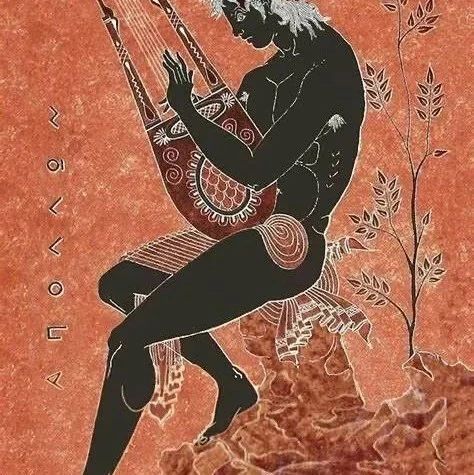On Music for Life 论音乐与生命的关系
On Music for Life: A Tribute to Friedrich Nietzsche’s On the Advantage and Disadvantage of History for Life
Note: This essay is written as a personal reflection of music in general, comprised of many thoughts and feelings the author has "collected" over the years. The author turns 16 today; let this essay be a birthday present for myself!
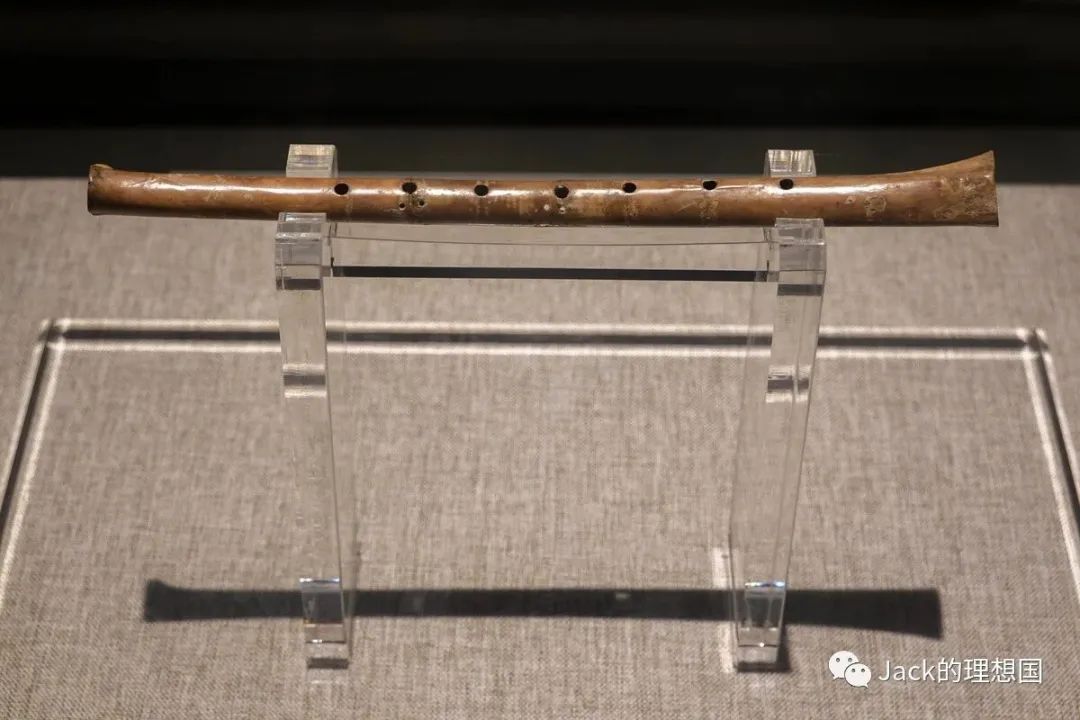
(A flute excavated from the site of Jiahu Culture, dating as far back as to 7000 BCE)
In the realm of science, music is a combination of sounds or vibrations of air. However, while this definition is based on empirical evidence and seems persuading enough for the average person today, it fails to embody and convey music's sheer power as a form of original art. The precise origin of music is still an unsolved mystery. Maybe, the ancestors of modern civilizations invented the earliest musical instruments by accident. Flutes dating back to the 6000s BCE were found by archaeologists at multiple sites, such as at the site of the Jiahu Culture in China. The flutes excavated at Jiahu might be born out of a pure interest of Chinese ancestors to play with the different effects of blowing and utilizing air. In any case, whatever its origin might be, music evolved into an integral element of major human cultures thanks to its ability to resonate with the various wants of human nature. As music develops, taking diverse forms of expression, it only intertwines more strongly with societies, breathing life into the culture of a nation. It would be difficult to conceive of any culture today that is alive without a component of music. To illustrate how music serves life, this essay will explain three kinds of life powered by the expressiveness, width, and depth of music.
Music first serves the emotional life, one that is not only sensitive to emotional changes within but also constantly yearns for the enrichment of emotions without. This individual perceives the world around them through the lens comprised of a multitude of feelings on the spectrum. The way this individual understands an event or another person is inherently through the establishment of emotional bonds. However, this reliance on emotions does not necessarily mean that reason is unforgotten. Reason only comes later at a point in cognition when the individual tries to interpret information in their mind fully. The primary means to probe the surrounding world is still feelings.
Music serves such an emotional individual in a most direct and powerful sense. To be music, some form of mood must be conveyed. Whether it is Western classical music, modern pop, or some indigenous music produced by local tribes, the content contains the power to unite and resonate, mainly because of the inherently complicated feelings involved. Since music undoubtedly carries bits of emotion within, it creates an almost unbreakable synergy when it reacts with the emotional individual. As an individual constantly immerses themselves in a sphere of feelings, music first provides an endless supply of combinations of sensational charges. Music ensures that these charges vitalize the individual’s life. The genuinely magical element of music is its ability to satisfy any emotional want. Think of the start of any piece as a white canvas. Then, if the musician desires to express a melancholic mood, they might add dark blue to the canvas. Later, the musician sinks into a dreamy mood. The canvas allows the musician to erase the dark blue and spray some light indigo or blend the latter with the former. The moods in music are not static or uniform. Instead, emotions become highly moldable, diverse, or even dramatic in a single piece.
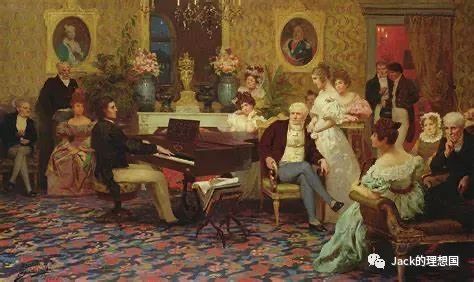
(Chopin playing the piano at a salon)
To illustrate how music serves the emotional individual by synergizing and supplying an endless chain of emotions, consider Chopin and his pieces. Chopin was an individual who approached his world with a heavy touch of feelings. He approached the reality of his mother nation Poland being divided and trampled with a patriotism that cannot be extinguished; he embraced life in the Paris salons with a sense of obsession and soberness; he was fiercely passionate and sorrowful at the same time. For Chopin, the world was made up of innumerable currents of sensation. His music served his emotional life. Composing and listening to some of his quieter nocturnes must have provided him peace and slight melancholy. His ballads and polonaises, however, brought fiery charges of patriotism and passion. Music was the sole channel through which he could express and hear his emotions, indulging himself in a rich spiritual life.
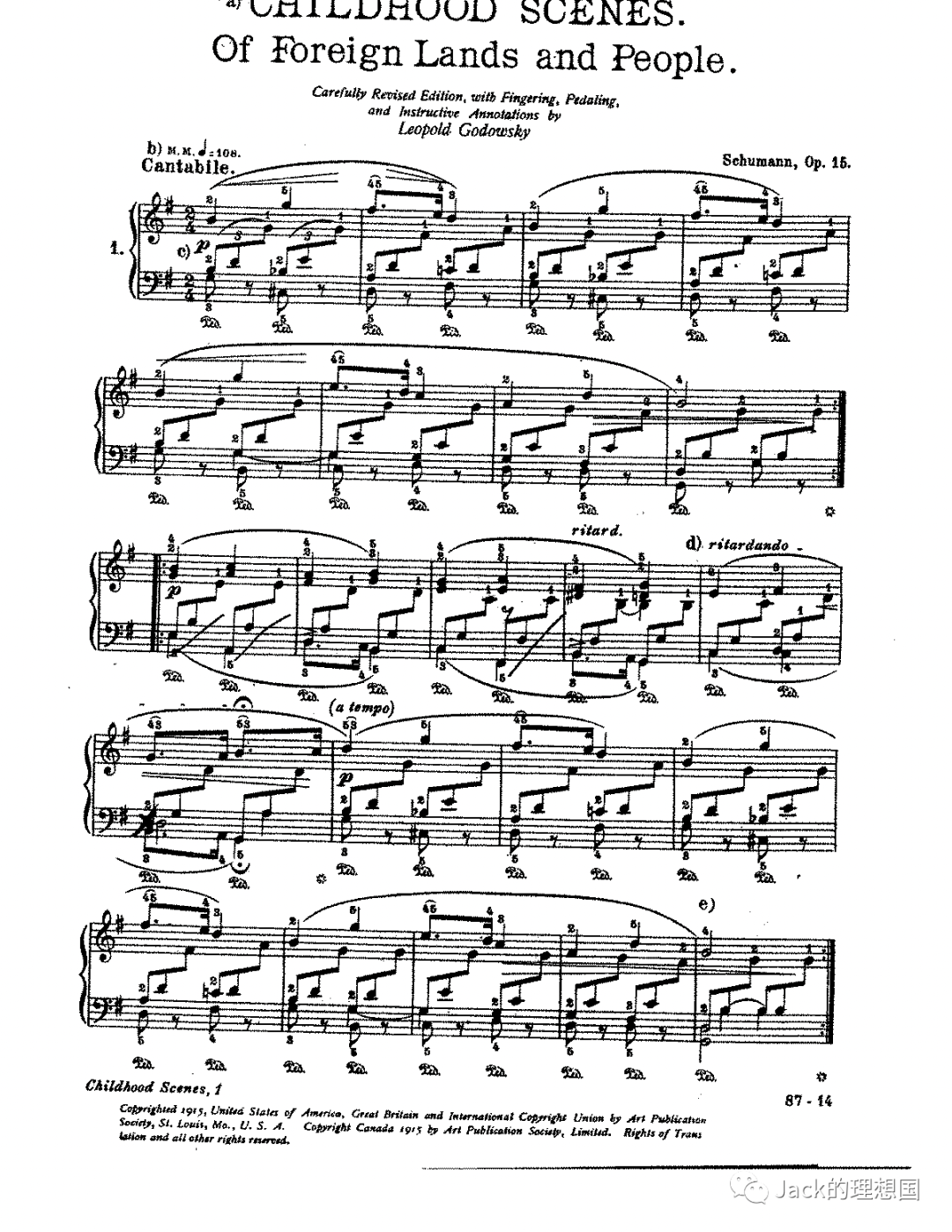
(The first piece in Schumann's "Kinderszenen", "Of Foreign Lands and People")
On a more fundamental level, what constitutes emotions? From a scientific perspective, the answer might lie in a look into hormone statuses. From an artistic and philosophical perspective, memories play an indispensable role in forming feelings. People react more emotionally if an occurrence reminds them of a memory. Some who have experienced the deaths of family members will generally feel tremendous grief upon seeing another case of death. This grief stems from a memory of losing a dear one. Music serves the emotional life due to its inextricable connection with memories. Even before the notes play out, when one sees a title of a work, some memories might already be evoked. For example, Schumann’s “Kinderszenen” or “Scenes from Childhood” is a set of pieces aiming to depict precious aspects of childhood, such as having fantastical dreams. The title “Scenes from Childhood” evokes one’s own memories of childhood, especially moments that they cherish. Then, when the music plays, coupled with these cherished memories, emotions may instantly flood the listener’s mind.
Music serves not just the emotional life but also the imaginative life, the second kind being considered. The imaginative life sets no boundaries, allowing the mind to wander freely, sometimes not necessarily following a strong logic. Imagination can take numerous forms and scopes, from a child imagining a wonderland to political philosophers envisioning a utopia. An imaginative life, compared to the emotional one, does not often come so naturally to every individual in a population. Conversely, the will and ability to imagine sometimes need nurturing under a generally free environment. An imaginative life cannot live prosperously if the right or ability to imagine is taken away. It constantly uses imagination to fill the gaps in its understanding of the surrounding world.

(Debussy's music has often been compared to Claude Monet's paintings. The imageries in Debussy's pieces, for the essayist, can take form and shape in the subjects of Monet's art)
If one leads an imaginative life, music serves this life as an omnipotent container of imagination. Music is ultimately flexible and “soft,” allowing one to communicate and receive messages through imagery. The freer music is, the more diverse the imageries will be within. In this regard, music resembles poetry. In a poem, key imagery and some supporting ones are often employed consistently by the poet to shape a sense of beauty and resonate with the reader through the whetting of their imagination. By crafting a melody and pairing it with subtly designed harmonies, a creator can powerfully imbue the music with images in their mind. Debussy is an outstanding composer who demonstrated this point perfectly. A unique melody harmonization may suddenly introduce a whole set of imaginative imageries in many pieces. For music to contain and serve the composer's imagination, one does not need to write a standard melody. A few distinctive combinations of harmony, a sudden change of texture, or an unexpected alteration of tempo might conjure up a diverse group of illusory images.
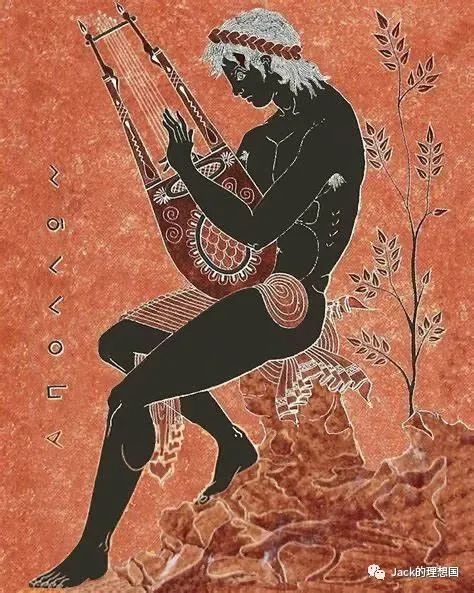
(Apollo playing the lyre, an instrument resembling the modern harp)
Moreover, music serves the imaginative life by encouraging the creator or the listener to continue “dreaming.” When one reads a book that piques their interest, they will be more than willing to continue reading; similarly, when one listens to a piece of music that allows them to wonder, they will be strongly encouraged to continue playing the music and letting visions go wild. For example, the ancient Greeks were quite devoted, as a culture, to the creation and development of music. During the creation process, music's power pushed the Greeks to imagine in increasingly bold and unrestrained ways. They conceived of a deity of music, Apollo; they came up with the previously nonexistent idea of a music festival. The shaping of Apollo as a god of music and the organization of music festivals show that music allowed Greek culture to expand imaginatively in various aspects. Even if one progresses to the chaotic modern world, the ability of music to encourage imagination only becomes more pronounced. Aided by multiple forms of media and methods to produce music, this art form has gained greater potential to resonate with the younger generations. In 1986, the Chinese rock singer Cui Jian rose to prominence with his hit single “Nothing to My Name.” Today, people widely regard him as the cornerstone of Chinese rock music. With the rise of Cui Jian, rock music encouraged the Chinese populace to reconsider and envision how they should lead their daily lives. There was more emphasis on embracing opportunity, diversity, and freedom through the 1980s and 90s.
Finally, music serves the critical life. This life, by definition, often views the surrounding environment with a critical mindset. This category includes revolutionaries, social critics, and those who yearn to see a change in the status quo. Music, for these people, is imperative sometimes, as it is usually the platform through which they deliver their messages. Music is “transparent,” to a considerable extent, in the sense that through its components, one can see the actual thoughts and emotions of the composer and, more importantly, empathize with them.
Throughout music history, the relationship between music and the critical life has been inextricable. The classical era from the 16th century to the early 20th century is often perceived as one devoid of protest music (i.e., music that aims to protest against a regional or global issue). However, this claim is invalid if one examines this period more carefully. Around 1840, the Italian romantic composer Giuseppe Verdi wrote his classic opera “Nabucco.” This opera tells the story of Nebuchadnezzar, the king of Babylon, and his exiled Hebrew slaves. In this opera, one famous piece is titled “Va, pensiero,” or “The Chorus of the Hebrew Slaves.” This short piece delivers the outcry of the Hebrew slaves to restore their homeland and break their chains. It can be viewed as an example of protest music. At the time of its creation, Verdi’s home country, Italy, was oppressed by the Austrians. Thus, while the piece shows the revolt of the Hebrew slaves against their Babylonian overlords, it can also be viewed as an outcry of the Italians against their Austrian overlords. In fact, after the premiere, shouts of “Freedom for Italy” came from members of the audience, who recognized themselves in the Hebrews of the opera. In this example, Verdi, a critical figure who, urged by patriotism, called for the liberation of Italy, conveyed his feelings through music.

(Bob Marley, the pivotal figure in recent Jamaican history who popularized reggae music and called for the eradication of racial discrimination)
Music has more effectively served the critical individual, such as Verdi, as time passed. Protest music became quite significant during the 20th century. In the developed Western world, calls for freedom and peace grew louder each decade. Music was the primary platform for many demanders of these ideals, such as Michael Jackson or John Lennon, to express their critical views on social norms and political matters. Songs like “We Are the World” by Michael Jackson, “Imagine” by John Lennon, and “Let It Be” by Paul McCartney spoke potently for the minds of their creators. In the parts of the world where people just ridded themselves of the yoke of colonialism, protest music served the critical life more directly. In Jamaica, for instance, some musicians, notably Bob Marley, utilized the local reggae music to call for equality and human rights. The power of music can be unimaginably immense. With the spread of protest music across the Western hemisphere, by the late 20th century, most countries came to believe, at least officially, in the sacredness of freedom, equality, and human rights.
Music intrinsically serves three kinds of life: the emotional, the imaginative, and the critical. One of the most apparent yet revealing takeaways from the history of music is that the flexibility and possibilities of this form of art are unparalleled. From the earliest music produced by the flutes of the Jiahu Culture eight millennia ago to the bedazzling array of genres people encounter today on the internet, the journey music has undertaken is undoubtedly convoluted. From a modern standpoint, music might serve other purposes and kinds of life in the future. Music might even “leave” the realm of pure art and evolve into something purely for the practical purpose of delivering instant fun. This trend is already arguably demonstrated on short video platforms now, as some rapid, mesmerizing clips of music that complement the video content often go viral. However, whatever form music takes, it will still support the expression of emotion, the desire to freely imagine, and the will to critique perceptively. This claim shall hold as long as music exists, as the passing of history verifies it. In the forests inhabited by hunter-gatherer societies, the plains cultivated by the first agricultural towns, the castles and palaces constructed by feudal states, and the half-virtual world we reside in today, music has always been the element that crosses the boundaries of space and culture, creating a unified force within.
《论音乐与生命的关系:致敬尼采〈历史对人生的利弊〉一文》
注:今天是作者16岁生日,这篇作文是送给自己的生日礼物!

(贾湖文化出土的骨笛,可追溯至公元前7000年)
根据科学研究,音乐是声音或空气振动的组合。然而,尽管这个定义是基于科学证据,且对今天的大众似乎也足够有说服力,但它却未能体现和传达音乐作为一种原创艺术的纯粹力量。音乐的确切起源至今仍是一个未解之谜。也许,现代文明的祖先是在无意中发明了最早的乐器。考古学家在中国贾湖文化遗址等多处遗址发现了公元前 6000 年代的笛子。贾湖出土的笛子出于中国先民对吹奏和利用空气产生不同效果而产生的兴趣。无论其起源如何,音乐都因其能够与人性的各种需求产生共鸣而逐渐成为人类文化中不可或缺的元素。随着音乐的发展和表现形式变得多样化,它与社会的交织也越来越紧密,为民族的文化注入了活力,很难想象当今有哪种文化的生命力离得开音乐。为了说明音乐是如何服务于生命的,本文将阐述,音乐的表现力、广度和深度服务于哪三类生命?
音乐首先服务于情感生命,这种生命不仅对内心的情感变化十分敏感,而且不断渴望接触外界的丰富情感,用多种情感组成的透镜来感知周围的世界。这类人理解事件或他人的方式本质上是通过建立情感纽带。然而,这种对情感的依赖并不一定意味着理性被完全遗忘。理智只是在认知过程中,当个体试图在头脑中全面解读信息时才会出现,探究周围世界的主要手段仍然是感觉。
音乐在最直接、最有力的意义上服务于这样的情感个体。音乐必须传达某种形式的情绪。无论是西方古典音乐,还是现代流行音乐,亦或是当地部落创作的土著音乐,其内容都蕴含着凝聚和共鸣的力量,尤其是因为音乐中蕴含着共通的复杂情感。由于音乐无疑蕴含着情感,当它与情感个体发生反应时,就会产生一种几乎牢不可破的协同作用。当个人不断沉浸在感情的世界中时,音乐首先提供了无穷无尽种情感的组合。音乐确保个人的生命因这些情感的组合而充满活力。然而,音乐真正的神奇之处在于它能够满足任何情感需求。任何乐曲的开头都均可被想象成一张白色的画布。如果音乐家想要表达一种忧郁的情绪,他们可能会在画布上添加一些深蓝色。之后,音乐家若沉浸在梦幻般的情绪中,那这块画布为音乐家提供了一个机会,可以擦去深蓝色,喷洒一些浅靛蓝色,或者将后者与前者融合在一起。音乐中的情绪不是一成不变或千篇一律的,相反,情绪在一首乐曲中变得高度可塑、多样甚至戏剧化。

(肖邦在一场沙龙弹琴,肖邦经常一人独守钢琴,沉醉地弹到第二天天亮,之后悄悄离去)
为了说明音乐是如何通过协同和提供无尽的情感链为情感生命服务,肖邦和他的作品是绝佳的例子。肖邦是一位带着浓厚情感去感知世界的作曲家。他以一种无法泯灭的爱国情怀来正视祖国波兰被分裂和践踏的现实;他以一种既沉醉又清醒的态度来拥抱巴黎沙龙的夜生活;他既充满炙热的激情,又充满暗淡的悲哀。对肖邦来说,世界是由无数的情感碎片组成的,他的音乐服务于他的情感生活。创作和聆听一些宁静的夜曲会让他感到平静和淡淡的忧郁;他的叙事曲和波罗乃兹舞曲则带来了炽热的爱国主义情怀和英雄主义情结。可以说,音乐是他唯一生命的渠道,他不仅可以通过音乐表达情感,还可以通过音乐倾听自己的心声,沉浸在丰满且深刻的精神生活中,他的钢琴纯粹地为他的心而歌唱。

(舒曼《童年情景》的第一首作品:《异国与异国的人民》)
从根本上讲,什么是情绪?从科学的角度来看,答案可能在于对荷尔蒙状态的研究。从艺术和哲学的角度来看,记忆在情感的形成过程中扮演着不可或缺的角色。如果某件事让人想起某段记忆,人们的情绪反应就会更强烈。一些经历过家人死亡的人在看到另一起死亡事件时通常会感到更加悲伤,这种悲伤源于失去至亲的记忆。音乐服务于情感生活,因为它与记忆有着千丝万缕的联系。甚至在音符奏出之前,当人们看到作品的标题时,可能已经唤起了一些脑海的记忆。例如,舒曼的《童年情景》(Kinderszenen)是一组旨在描绘童年珍贵经历的乐曲,如孩童时期夜晚做奇幻的梦。“童年情景 "这个标题唤起了人们对童年的回忆,尤其是自己珍爱着的童年时光的回忆。当音乐响起,这些珍贵的回忆涌现,听众的情绪会瞬间涌上心头。
音乐不仅服务于情感生命,它还服务于想象生命,即第二种生命。想象生命没有界限,任由思想自由徜徉,有时甚至并不一定遵循严谨的逻辑。想象可以有无数种形式和范围,从儿童想象的仙境到政治哲学家设想的乌托邦。与感性的生活相比,富有想象力的生活并不是每个人都能自然而然地拥有的。相反,有时想象的意志和能力需要在一个普遍自由的环境中培养。对于一个富有想象力的生命来说,如果想象的权利或能力被剥夺,它就无法繁荣地生活下去,因为它需要不断用想象来填补对周围世界理解的空白。

(德彪西的作品经常与克劳德·莫奈的画作进行比较。作者认为,德彪西乐曲中的意象往往在莫奈的作品中拥有了形体)
如果一个人过着富有想象力的生活,那么音乐就会充当无所不能的想象容器,为这种生活服务。音乐最终是灵活而 "柔软 "的,它允许人们以想象的形式传达和接收信息。音乐越自由,其中的意象就越多样。在这一点上,音乐与诗歌相似。在一首诗中,诗人往往会持续运用一个核心意象以及一些辅助意象,通过激发读者的想象力来塑造美感,引起共鸣。在音乐中,创作者通过精心设计旋律,并配以巧妙的和声,可以在音乐中绘制意象,有力地渲染到读者的脑海中。德彪西是一位杰出的法国浪漫主义时期作曲家,他完美地诠释了这一点。在许多作品中,旋律的独特和声可能会突然引入一整套富有想象力的意象群,例如粉色的云朵、静谧的湖水以及一位拥有亚麻色头发的少女。要使音乐包含并服务于作曲家的想象力,并不需要作曲家写出标准的,符合乐理的旋律。一些独特的和声组合、声部的突然变化或节奏的意外调整都可能使人联想到各种虚幻的形象。

(阿波罗演奏七弦竖琴,现代竖琴的鼻祖)
此外,音乐还能鼓励创作者或聆听者继续 "浮想",从而为想象生命服务。当一个人读了一本书并对其产生兴趣时,他就会非常愿意继续读下去;同样,当一个人听了一首音乐并对其产生好奇时,他就会被强烈鼓励继续演奏这首音乐,让想象力尽情驰骋。例如,作为一种文化,古希腊人对音乐的创造和发展相当投入。在创作过程中,音乐的力量促使希腊人以越来越大胆和无拘无束的方式进行想象。他们构想出了音乐之神阿波罗;他们提出了举办盛大音乐节的想法。阿波罗作为音乐之神的塑造和音乐节的举办表明,音乐确实使希腊文化在各个方面都得到了想象的拓展。即使进入纷乱的现代社会,音乐鼓励想象的能力只变得更加突出。在多种媒体形式和音乐制作方法的辅助下,音乐这种艺术形式越来越有可能引起年轻一代的共鸣。1986 年,中国摇滚歌手崔健凭借热门单曲《一无所有》一举成名,如今,人们普遍认为他是中国摇滚乐的基石人物。随着崔健的崛起,摇滚乐鼓励中国民众重新思考和设想自己的日常生活方式,考虑到一些从未被体验过的生命价值。在 20 世纪 80 年代和 90 年代,人们更加强调拥抱机遇、多样性和自由的重要性。
最后,音乐服务于批判生命。顾名思义,这种生命往往以批判的心态看待周围的环境。这类人包括革命者、社会批评家与渴望改变现状的人。对这些人来说,音乐有时势在必行,因为音乐通常是他们传递信息的平台。音乐在相当程度上是 "透明 "的,因为通过音乐的组成部分,人们可以看到作曲家的真实思绪并与他们产生共鸣。
纵观音乐史,音乐与批判生命之间的关系密不可分。从 16 世纪到 20 世纪初的古典音乐时代通常被认为是一段没有抗议音乐(即旨在抗议某个地区或全球问题的音乐)的时代。然而,如果对这一时期进行更仔细的研究,就会发现这种说法是不正确的。1840 年左右,意大利浪漫派作曲家朱塞佩-威尔第创作了经典歌剧《纳布科》。这部歌剧讲述了巴比伦国王尼布甲尼撒和他流放的希伯来奴隶的故事。在这部歌剧中,有一首著名的乐曲名为 "Va, pensiero",或 "希伯来奴隶的合唱"。这首短歌表达了希伯来奴隶要求恢复家园、打破枷锁的呼声,它可被视为抗议音乐的典范。创作此曲时,威尔第的祖国意大利正遭受奥地利人的压迫。因此,虽然这首乐曲表现的是希伯来奴隶对巴比伦霸主的反抗,但也可以看作是意大利人对奥地利霸主的强烈抗议。事实上,在首演之后,就有观众现场喊出了 "意大利是自由的 "的口号,他们在歌剧中的希伯来人身上找到了自己的影子。在这个例子中,威尔第作为一位批判者,在爱国主义的驱使下,呼吁解放意大利,并通过音乐传达了自己的情感。

(鲍勃·马利,牙买加传奇音乐人。他大力推广了雷鬼音乐等多种当地音乐,同时为消除种族歧视作出卓越贡献)
随着时间的推移,音乐为威尔第这样的批判者提供了更有效的服务。抗议音乐在 20 世纪变得相当重要。在西方发达国家,要求自由与和平的呼声每十年都在高涨。音乐是迈克尔-杰克逊(Michael Jackson)或约翰-列侬(John Lennon)等许多理想诉求者表达其对社会规范和政治事务的批判性观点的主要平台。迈克尔·杰克逊的《我们是世界》、约翰·列侬的《想象》和保罗·麦卡特尼的《顺其自然》等歌曲有力地表达了创作者的思想。在世界上刚刚摆脱殖民主义枷锁的地区,抗议音乐更直接地服务于批判性的生命。例如,在牙买加,一些音乐家,特别是鲍勃·马利,利用当地的雷鬼音乐呼吁平等和人权。音乐可以迸发出难以想象的磅礴力量。随着抗议音乐在西半球的传播,到 20 世纪末,大多数国家开始相信,至少是正式相信,自由、平等和人权是神圣的。
总体而言,音乐本质上服务于三种生命:情感生命、想象生命和批判生命。从音乐史中得到的一个最明显而又最有启发性的启示是,这种艺术形式的灵活性与呈现的可能性是无与伦比的。从八千年前贾湖文化最早的笛子所创造的音乐,到今天人们在互联网上接触到的令人眼花缭乱的各种音乐形态,音乐所走过的历程无疑是复杂的。从现代的角度来看,音乐在未来有可能为其他目的和生命形式服务。音乐甚至有可能 "脱离 "纯艺术的范畴,演变成一种纯粹以提供即时乐趣为实用目的的造物。目前,短视频平台上已经出现了这种趋势,一些与视频内容相辅相成的快速、魔性的音乐片段往往会一夜爆红。然而,无论音乐以何种形式出现,它仍将支持真切情感的表达、自由想象的欲望与敏锐批判的意志。只要音乐存在,这种说法就会成立,历史的流逝已经验证了这一点。无论是在狩猎采集社会居住的森林中,在最早的农业城镇开垦的平原上,还是在封建王国建造的城堡与宫殿里,亦或者是在我们今天居住的半虚拟世界下,音乐始终是跨越空间及文化界限的元素,在人类社会内部形成一种不可阻挡的统一力量。
- 本文标签: 原创
- 本文链接: http://www.jack-utopia.cn//article/611
- 版权声明: 本文由Jack原创发布,转载请遵循《署名-非商业性使用-相同方式共享 4.0 国际 (CC BY-NC-SA 4.0)》许可协议授权
